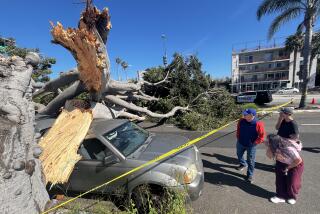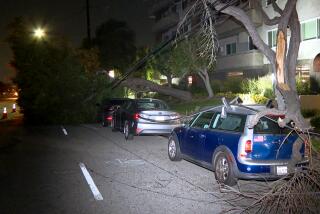Santa Anas Don Winter Disguise for Latest Blow
Call them the Santa Anas with a winter twist. While locals are more likely to associate the legendary gusts with hot weather and deadly brush fires, Monday’s chilly winds made perfect sense to meteorologists.
A massive stretch of icy air traveling in the atmosphere from the Northwest blanketed the region, sinking toward the surface and mixing with a similar band of high-pressure air gusting from the Great Basin of Nevada and western Utah.
The two bands of air converged with another low-pressure system from northern Mexico, ultimately shooting colder than usual winds through area canyons and mountain passes and wreaking havoc from Ventura to San Diego.
Santa Ana winds can occur at any time of the year, but arrive most frequently during fall and winter months. The cold, high-pressure winds pick up speed and heat up as they surge and descend from the Great Basin toward Southern California.
“We have cold Santa Anas and warm Santa Anas. The thing that differentiates them is the temperature of the air,” said Bill Hoffer, a National Weather Service meteorologist. “Colder air tends to sink and forces warmer air upward.”
Downtown Los Angeles recorded a high of 62 degrees Monday, three degrees lower than its normal high on Jan. 6. Burbank, whose normal high was 66, recorded 61.
The experts say the winds all combine to create one vast system locally, with winds building up behind--and then squeezing through--mountain passes, picking up speed as they travel to lower elevations.
“It’s like a river flowing down a narrow canyon,” said Vladimir Ryshko, another meteorologist with the Weather Service. “You get the acceleration.”
The San Gabriel Valley suffered the brunt of the winds primarily because the canyons and passes that surround it--including the El Cajon Pass--lie directly in the path of gusts traveling from the Great Basin to the north.
By contrast, the San Fernando Valley was spared some of the wind-driven force because of its own unique position.
“The San Fernando Valley is a little more enclosed [than the San Gabriel Valley],” said Jon Erdman, a meteorologist with WeatherData Inc., which provides forecasts for The Times. “It’s more like a bowl, if you will.”
The experts expect the strong, cold winds to continue through at least this afternoon.
The winds should begin to decrease for the remainder of the week as the high-pressure system currently over the Great Basin moves southeast and the cold band of air hovering over local skies also moves south.
Breezy but sunny conditions are expected by the weekend.
* MAIN STORY: A1
(BEGIN TEXT OF INFOBOX / INFOGRAPHIC)
Trouble on the Wind
Santa Ana winds originating hundreds of miles away over the Great Basin pick up speed as they surge and descend toward Southern California. A cap of high pressure over the Southland is helping to push gusts as high as 77 mph and contributing to the winds’ chilly temperatures.
Path of Santa Anas: The combined flow of clockwise winds around a strong Great Basin high pressure system and counterclockwise winds around a weak northern Mexico low are pushing strong winds through the canyons into the Southland.
* Source: National Weather Service.
More to Read
Sign up for Essential California
The most important California stories and recommendations in your inbox every morning.
You may occasionally receive promotional content from the Los Angeles Times.










